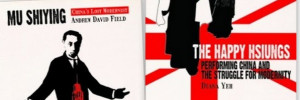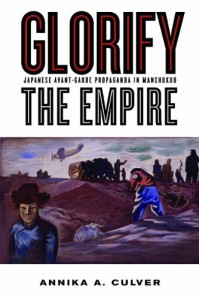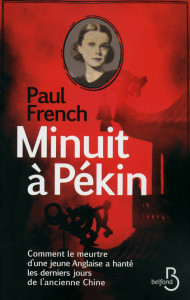Posted: March 8th, 2014 | No Comments »
Penguin China have commissioned a bunch of writers to think about the issues involving China and the First World War. In this centenary year there’s bound to be a flood of books, TV, movies on WW1 but China’s involvement in the conflict and the effects of that war on the fledgling republic and its people are generally poorly covered. So a series that adds something different to perspectives on both the Great War and China’s history. All are available as e-books with paperbacks available in Asia and Australia.
There’s a whole bunch of great authors involved including Jonathan Fenby, Mark O’Neill, Anne Witchard, Frances Wood, Robert Bickers and myself (my own contribution on China at the Paris Peace Conference and the ramifications of China’s betrayal by the Great Powers at Versailles is out in the spring).
The series is now launched with Jonathan Fenby’s The Siege of Tsingtao, the only battle of WW1 to be fought in East Asia with the Japanese seizure of the German possessions in Shantung (Shandong). Jonathan will taking about the book and the Siege at the Beijing International Literary Festival on the 14th March (click here)

Also up and out now is Mark O’Neill’s The Chinese Labour Corps, the story of the thousands of Chinese men recruited by the British and French to provide logistical support and clean the battlefields in Europe. It’s a fascinating story and little known outside China history buffs (I’ve blogged on it here, here and here).
Mark will also be speaking at the Beijing festival (March 9th) on China and WW1 with Paul Ham (author of 1913: The Eve of War) and Steven Schwankert (author of Poseidon: China’s Secret Salvage of Britain’s Lost Submarine)

Posted: March 7th, 2014 | No Comments »
I remember reading a version of this weird tale of the Maoist years when it was released in a limited edition to raise money for the Sichuan earthquake back in 2008. Now Alfreda Murck has published it as a book – well worth a read……Venerate the Mango Comrades!

In August 1968, the Pakistani foreign minister visited Beijing and presented Chairman Mao with a crate of mangoes. Apparently, Mao immediately sent the mangoes, a fruit unknown so far in China, as a gift to the ‘Worker-Peasant Mao Zedong Thought Propaganda Teams’ deployed into Quinghua University to put down warring factions of Red Guards and occupy the campus, with the implicit political message that workers were now made managers of education. The exotic fruit were then distributed over the following weeks to various factories. Thus the mangoes, perceived as coming from Chairman Mao, transformed from mere fruit into near-divine symbol. They were celebrated by the workers as tokens of Mao’s love and compassion and worshipped as a kind of religious relic. The Golden Mango powerfully symbolised the slogan “The working class must be the leaders in everything”, and soon appeared on all kinds of household products. The new book Mao’s Golden Mangoes and the Cultural Revolution illustrates how factory workers tried to preserve Chairman Mao’s precious gift, how the mango transformed into a religious symbol, and how the political spectacle of the 1968 National Day Parade featured the mango.
Posted: March 6th, 2014 | No Comments »
Both our 2014 RAS authors, Andrew Field and Diana Yeh, will appear to the Beijing International Literary Festival this March….

9 March 2014: China’s Lost Modernist:
Andrew Field on Mu Shiying
With Neil Schmid
When: 9 March 12:00 p.m.
Where: The Beijing Bookworm
Tickets: RMB 65
About:
When the avant-garde writer Mu Shiying was assassinated in 1940, China lost one of its greatest modernist writers and Shanghai lost the most detailed chronicler of its demi-monde night life. In his recent publication of translation and commentary, Andrew Field argues that Mu Shiying advanced modern Chinese writing beyond the vernacular expression of the May 4th giants Lu Xun and Lao She to even more starkly reveal the alienation at the heart of cosmopolitan Shanghai. Each of the five stories translated in Field’s book focus on the anxiety-ridden relationships of the modern city and its culture of consumption. Neil Schmid, a China scholar and honorary editor of the Journal of the Royal Asiatic Society, will talk to Andrew Field about the life of this fascinating and forgotten citizen of Shanghai.
17 March 2014: The Happy Hsiungs:
Diana Yeh on a Chinese-British Literary Couple
With Alan Babbington-Smith
When: 17 March 1:00 p.m.
Where: The Beijing Bookworm
Tickets: RMB 65
About:
The Happy Hsiungs recovers the histories of a Chinese literary couple who lived, worked and wrote in Britain from the 1930s onwards. Shih-I Hsiung shot to worldwide fame with his play Lady Precious Stream, while Dymia Hsiung was the first Chinese woman to publish an account of life as an immigrant in Britain. Diana Yeh recounts the Hsiungs’ childhoods in turn-of-the-century China, their youth in the radical May 4th era, and their lives in Britain and the United States. Alan Babbington-Smith will discuss with Yeh how the Hsiungs’ “performed” identities conformed to Western ideals of gender, sexuality, and ‘Chineseness’.
Posted: March 6th, 2014 | No Comments »
An interesting new book on Japanese propaganda in Manchuria in the 1930s…..
 In the 1930s and ’40s, Japanese political architects of the Manchukuo project in occupied northeast China realized the importance of using various cultural media to promote a modernization program in the region, as well as its expansion into other parts of Asia. Ironically, the writers and artists chosen to spread this imperialist message had left-wing political roots in Japan, where their work strongly favoured modernist, even avant-garde, styles of expression.
In the 1930s and ’40s, Japanese political architects of the Manchukuo project in occupied northeast China realized the importance of using various cultural media to promote a modernization program in the region, as well as its expansion into other parts of Asia. Ironically, the writers and artists chosen to spread this imperialist message had left-wing political roots in Japan, where their work strongly favoured modernist, even avant-garde, styles of expression.
In Glorify the Empire, Annika Culver explores how these once anti-imperialist intellectuals produced modernist works celebrating the modernity of a fascist state and reflecting a complicated picture of complicity with, and ambivalence towards, Japan’s utopian project. During the war, literary and artistic representations of Manchuria accelerated, and the Japanese-led culture in Manchukuo served as a template for occupied areas in Southeast Asia. A groundbreaking work, Glorify the Empire magnifies the intersection between politics and art in a rarely examined period in Japanese history.
Posted: March 5th, 2014 | No Comments »
The old E&O Hotel in Penang (which rather wonderfully still stands), known to regulars as the “Eat and Owe” produced some lovely ephemera for guests. Here’s a couple of examples….The E&O was one of the hotels owned by the Armenian Sarkie Brothers, who’s Oriental chain included the great Strand in Rangoon (see this old post) and others. Maugham, Kipling, Coward and the usual gang all stayed there.
 An E&O luggage label
An E&O luggage label

An E&O beer mat
Posted: March 5th, 2014 | No Comments »
Another book on the “hump” has appeared….

The USAAF responded to the requirement to keep China engaged against Japan by conducting two distinct air supply operations, a tactical air supply mission to Burma and a strategic air supply effort over the Himalayas to China. The tactical air supply effort to Burma supported offensive combat operations and the construction of the Ledo Road, while the Hump airlift directly contributed to the American strategic objective. Despite Stilwell’s stubborn commitment to the Ledo Road as the main effort to supply the Chinese and to the necessary use of tactical air supply to support this and other ground operations in Burma, the key contribution to the success of keeping China in the war against Japan was ultimately the strategic air supply missions over the Hump. This thesis reviews how the operational airlift efforts within the CBI supported both efforts and examines the challenges, processes, and development of air supply. The fundamental question associated with this effort concerns how the USAAF responded to seemingly competing air supply requirements in the CBI Theater in order to keep China in the war against Japan.
Posted: March 4th, 2014 | No Comments »
I’ve blogged before about Chung Ling Soo (here, here and here), actually William Ellsworth Robinson, an American magician who worked mostly in Britain before the First World War impersonating a Chinese magician in full mandarin regalia until a catching a bullet trick went wrong and he ended up dead at the Wood Green Empire. So thanks to the regular reader who sent me a copy of his own personalised headed paper….

Posted: March 3rd, 2014 | No Comments »
Courtesy of the publishers Belfond, Midnight in Peking is now Minuit a Pekin and 21.50 of your finest euros! C’est fantastique!!

Entre document et polar, un « true crime » exceptionnel. Dans les derniers jours du Pékin colonisé, juste avant l’invasion japonaise, en plein chaos diplomatique, une enquête minutieuse et palpitante qui résout un mystère vieux de près de 80 ans. Un texte qui se lit comme un polar et qui a justement été récompensé par les prestigieux Dagger et Edgar Awards.
Entre polar compulsif et document édifiant, un true crime exceptionnel. Dans le Pékin des années 1930, en plein chaos diplomatique et dépravation morale, une enquête minutieuse qui résout un mystère vieux de près de quatre-vingts ans.
Par une froide nuit de janvier 1937, au pied de la tour de garde du vieux quartier de la Légation, le corps atrocement mutilé d’une jeune femme est retrouvé. Elle s’appelait Pamela Werner, elle avait vingt ans, elle était la fille adoptive de l’ancien consul de Grande-Bretagne.
Crime d’un rôdeur ou affaire d’État ? Dépêché par le Foreign Office, l’inspecteur Dennis lance l’enquête pour s’apercevoir rapidement que personne n’est pressé de voir la vérité triompher. Car Pékin est alors une véritable poudrière. Tandis que diplomates et seigneurs de la guerre complotent dans les fumeries d’opium, les expatriés se plongent dans une frénésie d’alcool, de drogue et de luxure pour oublier les rumeurs de l’invasion japonaise imminente et la fin annoncée de leurs privilèges. Et l’horrible assassinat de Pamela Werner pourrait bien faire l’effet d’une bombe diplomatique…
Soixante-quinze ans plus tard, après une enquête qui l’amènera à interroger les derniers témoins vivants et fouiller les notes jusqu’alors classées secret défense du père de la victime, Paul French dévoile le nom du monstre qui a tué Pamela et terrorisé Pékin.









